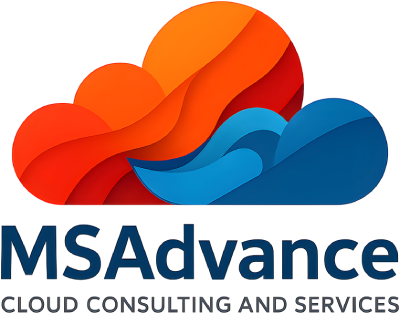Complete Guide: How to Configure Microsoft Purview (2025) — Data Security, Governance & Compliance
A practical, up-to-date manual to configure Microsoft Purview end to end. We explain what Purview is, what it’s for, where it’s used, and who should administer it. Includes a step-by-step rollout, PowerShell and Azure CLI commands, examples of sensitivity and retention labels, DLP (including Endpoint DLP and Copilot), eDiscovery (Premium), Insider Risk with Adaptive Protection, Information Barriers, and data governance (Data Map & Unified Catalog), all with official Microsoft links.
Want to roll out Microsoft Purview with risk control and measurable outcomes?
At MSAdvance we blend Microsoft best practices with automation and production-ready playbooks.
Executive summary — Purview in 5 ideas
- Unified suite bringing together data security, risk & compliance, and data governance in a single portal with simplified navigation.
- Scopes: protects and governs data across Microsoft 365, endpoints, multicloud, and on-prem via Data Map/Unified Catalog.
- Key use cases: sensitivity & retention labeling, DLP (including Endpoint DLP), eDiscovery, auditing, Information Barriers, Insider Risk, and Adaptive Protection.
- Governance: source registration & scanning, auto-classification, lineage, and a unified catalog; compatible with Microsoft Fabric/OneLake.
- Licensing: advanced capabilities (e.g., Audit Premium, eDiscovery Premium, Insider Risk, Adaptive Protection) require E5/E5 Compliance.
What Microsoft Purview is and where it’s used
Microsoft Purview is Microsoft’s umbrella for data security, governance and compliance. It centralizes protection (labels, DLP), risk & compliance (eDiscovery, audit, information barriers, insider risk), and governance (Data Map, scans, catalog). It’s administered from the Microsoft Purview portal.
It’s used across Microsoft 365, Windows/macOS endpoints, Azure data sources, multicloud, and on-prem via connectors and the self-hosted integration runtime for scanning.
Who should use it & recommended roles
- Compliance Admin / Data Security Admin: configure labels, DLP, retention, audit, and eDiscovery.
- Insider Risk Admin/Analyst: insider risk policies and Adaptive Protection.
- Data Curator/Data Reader (governance): catalog, glossary, domains, and scans in Data Map.
- Delegated admins with admin units to scope DLP and other policies by region or organization.
Requirements & licensing
Purview is included at various levels in Microsoft 365. For advanced capabilities (e.g., Audit Premium, eDiscovery Premium, Insider Risk, Adaptive Protection), you need Microsoft 365 E5 or the E5 Compliance add-on.
In DLP, supported locations include Exchange, SharePoint, OneDrive, Teams, endpoints, and Microsoft 365 Copilot.
Architecture & solutions
- Data security: sensitivity labels and DLP policies (including endpoint), controls in Copilot.
- Risk & compliance: retention/records, eDiscovery, audit, Insider Risk/Adaptive Protection, Information Barriers, Communication Compliance.
- Data governance: Data Map & Unified Catalog to register, scan, classify and govern data (Azure, on-prem, multicloud), integrated with Microsoft Fabric/OneLake.
Four-phase rollout plan
- Foundation: review licenses & roles; enable Audit; define DLP and retention domains/scopes.
- Protection: create sensitivity labels, publish policies, and turn on DLP (simulate > enforce); onboard devices for Endpoint DLP.
- Risk & compliance: retention policies, operational eDiscovery (Premium), and audit workflows.
- Governance: create the Purview (governance) account, register sources, run scans, glossary & domains; integrate Fabric/OneLake if relevant.
Provisioning & first-run of the Purview portal
Go to the Microsoft Purview portal to manage security, risk and governance with unified navigation. Early setup should prioritize security, reversibility, and traceability across people (roles), platform (licenses and connectivity) and process (controlled changes, testing, and KPIs).
1) Prerequisites & licensing
- Initial scope (first month): Information Protection (labels), DLP (including Endpoint), Data Lifecycle Management (retention/records), eDiscovery (Premium), Audit, Insider Risk, Information Barriers, Communication Compliance, and Governance (Data Map/Unified Catalog).
- Licensing: advanced capabilities (Audit Premium, eDiscovery Premium, Insider Risk, Adaptive Protection, IB) require E5 or the E5 Compliance add-on. Prioritize licenses for higher-risk cohorts.
- Portals: use the Microsoft Purview portal for Security/Risk/Compliance and the Purview (Governance) account in Azure for Data Map/scans/catalog.
2) Permissions & environment separation
- Group-based RBAC (avoid individual assignments): Information Protection Admin, DLP Admin, Records/Compliance Admin, eDiscovery Manager/Admin, Audit Admin, Insider Risk Admin/Analyst, IB Admin, Communication Compliance Admin, Purview Data Curator/Reader.
- Administrative units: delegate by country/subsidiary or data domain (applies to DLP, Retention, Insider Risk, Communication Compliance…).
- Environments: define Dev/Test (pilot), Pre-prod, and Prod. Change flow Dev → Pre → Prod with dual approval.
3) Connectivity, health & auditing
- Microsoft 365 connectivity: allow endpoints through proxy/firewall; keep Office updated for built-in labeling.
- Unified audit: validate event ingestion (≈180 days standard); if you need more, enable extended retention and/or export to your SIEM.
- Device onboarding (Endpoint DLP): onboard Windows 10/11 and macOS via Intune/GPO/script; organize by device groups (VIP, lab, high risk).
4) Guided first-run in the portal
- Under Solutions, run the wizards for Information Protection, DLP, DLM, eDiscovery, Audit, and Insider Risk. Document decisions (who, when, why).
- Under Roles & scopes, create administrative units and assign owners by region/area with explicit scope.
- Under Audit, confirm default retention and plan automatic export or scheduled queries.
5) Initial guardrails
- Labels: minimum set (Public, Internal, Confidential, Secret) with mandatory labeling + a default label. Pilot per group.
- DLP: global policy in audit mode (Exchange/SharePoint/OneDrive/Teams and, if applicable, Copilot). Observe for 2–3 weeks and harden in waves.
- Retention: broad policy (e.g., 7 years across Exchange/SPO/OD) + Record labels for critical series.
Acceptance checklist (exit criteria for Phase 0)
| Control | Acceptance criteria | Evidence |
|---|---|---|
| RBAC | Roles assigned to groups; no individual permissions | Role export + screenshots |
| Audit | Events visible + export enabled | CSV from the last 7 days |
| Labels | Minimum set published and tested | List + Office tests |
| DLP | Global policy in audit mode + alerts | Activity explorer with events |
| Retention | Global policy applied | Scope report |
Useful commands (kick-off)
# Connect to Security & Compliance PowerShell Install-Module ExchangeOnlineManagement -Scope CurrentUser Import-Module ExchangeOnlineManagement Connect-IPPSSession # View role groups related to eDiscovery Get-RoleGroup | Where-Object {$_.Name -like "eDiscovery*"} # Audit: search (48h) and export Search-UnifiedAuditLog -StartDate (Get-Date).AddDays(-2) -EndDate (Get-Date) ` -Operations FileDownloaded, MailItemsAccessed -ResultSize 500 | Export-Csv .\audit.csv -NoTypeInformation Create governance account (Data Map) in Azure — quick command
# Purview extension for Azure CLI (installs on first use) az extension add --name purview # Create Purview account (governance). Requires subscription permissions and registered provider. az purview account create \ --name <AccountName> --resource-group <RG> --location <region> \ --sku Standard Then use the Purview governance portal to register sources and define scans (Managed Identity or credentials; SHIR for on-prem).
Sensitivity labels — types, scope & publishing
Sensitivity labels classify and protect content; they can include encryption, visual markings, and access controls. They apply to files and email, to containers (Teams, M365 Groups, SharePoint/OneDrive), and to Power BI. The goal is to reduce user friction while the system enforces policy.
Taxonomy design & publishing
- Base levels: Public → Internal → Confidential → Secret. Add sub-labels by regulation (GDPR, PCI, HIPAA) or by business unit.
- Publishing policies: publish to groups (pilot, production, externals) with mandatory labeling, default label, downgrade justification, and policy tips in Office.
- Governance: define owners for label creation/approval and periodic reviews to avoid label sprawl.
Protections by type
- Files/email: encryption with user/group/domain permissions, visual markings (header/footer/watermark), access expiration, “Do not forward”.
- Containers: control privacy (public/private), guest access, external sharing, and access from unmanaged devices.
- Power BI: labels are inherited on export and can be combined with Power BI DLP.
Auto-labeling (in transit & at rest)
- Sensitive information types (SIT): local PII (DNI/NIF/NIE, IBAN, passport), financial, health; use format and proximity checks.
- EDM (Exact Data Match): hashed dictionaries (customer IDs, contract numbers) for exact matching with a low false-positive rate.
- Trainable classifiers: trained with real documents (contracts, résumés, invoices) to detect semantic patterns.
Clients & coverage
- Office (Windows/macOS/web): use built-in labeling. Avoid coexistence with legacy AIP clients.
- MIP Scanner: for on-prem repositories; run scheduled scans with managed identity or constrained credentials.
Create & publish with PowerShell (basic example from the original article)
# 1) Connect to Security & Compliance PowerShell Install-Module ExchangeOnlineManagement -Scope CurrentUser Import-Module ExchangeOnlineManagement Connect-IPPSSession # MFA friendly # 2) Create a sensitivity label New-Label -Name "Confidential" -Tooltip "Internal data" ` -EncryptionEnabled $true -ContentType "File, Email" # 3) Publish the label to all users New-LabelPolicy -Name "Confidential-Publication-Policy" -Labels "Confidential" -ExchangeLocation All PowerShell & Graph (advanced)
# Create and publish (extended version) Connect-IPPSSession New-Label -Name "Confidential" -EncryptionEnabled $true ` -ContentMarkingHeaderEnabled $true -ContentMarkingFooterEnabled $true New-LabelPolicy -Name "LP-Confidential" -Labels "Confidential" ` -ExchangeLocation All -SharePointLocation All -OneDriveLocation All -ModernGroupLocation All POST https://graph.microsoft.com/v1.0/drives/{driveId}/items/{itemId}/assignSensitivityLabel Content-Type: application/json { "assignmentMethod": "standard", "justificationText": "Rule-based classification", "labelId": "{label-guid}" } Validation & KPIs
- Use Content explorer and Activity explorer to track label coverage/usage.
- KPIs: % of labeled content, time-to-adoption, downgrade rate, false positives/negatives per detector.
- Adoption materials: a “when to choose each label” guide and 2-minute videos.
Data Loss Prevention (DLP), Endpoint DLP & Copilot
DLP protects data in Microsoft 365 (mail, sites, OneDrive, Teams), on devices (Endpoint DLP), and in Microsoft 365 Copilot. It uses sensitive information types, dictionaries, sensitivity labels, and contextual conditions. The key: start in audit mode, measure, and harden in phases.
Anatomy of a DLP policy
- Scopes: locations (M365, Devices, Copilot) + filters (groups, sites, labels, file size/type).
- Conditions: SITs, EDM, trainable classifiers, sensitivity labels, keywords, counts and proximity.
- Actions: audit, notify (policy tips + email), block, block with override, open incident/alert.
- Modes: Simulation → Notification → Enforcement (blocking) in waves.
Endpoint DLP (Windows/macOS)
- Onboarding via Intune, GPO, or script. If you already use Defender for Endpoint, it inherits onboarding.
- Endpoint settings: allowed/blocked domains, printers, apps and excluded paths; control USB, copy/paste, web upload, printing, and screen capture.
- Device groups: targeted policies for VIPs, dev, labs, or third parties.
- UX: policy tips and override with justification to preserve business continuity.
DLP for Copilot
Include the Copilot for Microsoft 365 location in your policies. Example: audit and then block prompts/responses that contain sensitive PII or content labeled ≥ “Confidential”.
Create a DLP policy (basic PowerShell — original block)
# DLP policy and simple rule (example) New-DlpCompliancePolicy -Name "DLP-PII-Global" -Mode TestWithoutNotifications ` -ExchangeLocation All -SharePointLocation All -OneDriveLocation All New-DlpComplianceRule -Name "Detect-PII" -Policy "DLP-PII-Global" ` -ContentContainsSensitiveInformation @{Name="U.S. Social Security Number (SSN)"; MinCount="1"} ` -BlockAccess $true -UserNotification $true PowerShell (extended creation)
Connect-IPPSSession # DLP policy in simulation (M365) New-DlpCompliancePolicy -Name "DLP-ES-PII" -ExchangeLocation All -SharePointLocation All -OneDriveLocation All -TeamsLocation All ` -Mode TestWithoutNotifications # Rule: detect Spanish DNI with blocking and justification New-DlpComplianceRule -Name "Rule-DNI" -Policy "DLP-ES-PII" ` -ContentContainsSensitiveInformation @{Name="Spain DNI"; MinCount="1"} ` -BlockAccess $true -BlockAccessScope "All" -UserNotification "Email" Reference recipes
Spain PII (DNI/NIF) in M365
- Locations: Exchange/SharePoint/OneDrive/Teams
- Condition: SIT “Spain DNI” ≥ 1
- Action: Notify + “Block with override”
“Secret” data to disallowed domains (endpoint)
- Location: Devices
- Condition: label = Secret + upload to blocked domain
- Action: Block + high-severity alert
Copilot without PII or “Secret”
- Location: Copilot
- Condition: PII or label ≥ Confidential
- Action: Audit 2 weeks → gradual blocking
Operations & tuning
- Review Activity explorer and Alerts daily during the first weeks.
- Define severity thresholds and response playbooks (who, how fast, how to document).
- Audit exceptions (overrides) and consolidate specific rules if they recur.
Retention & Records — Data Lifecycle Management
Retention policies and retention/record labels allow you to retain or delete content based on business and regulatory rules. They support static scopes and adaptive scopes. They are the anchor of your governance & compliance program.
Key concepts
- Retain: keep for X days/years; upon expiry, delete or allow a user decision.
- Records: immutability and additional controls (edit/delete lock). Regulatory record further tightens restrictions.
- Events: milestone-based retention (contract end, employee offboarding) with event-based retention.
- Adaptive scopes: dynamic application by attributes (department, country, site labels, etc.).
- Teams: distinct policies for chats, standard channels, and private/shared channels.
Create a 7-year retention policy (original block)
# 7-year retention policy for Exchange/SharePoint/OneDrive New-RetentionCompliancePolicy -Name "RET-7Years" -ExchangeLocation All -SharePointLocation All -OneDriveLocation All New-RetentionComplianceRule -Name "RET-7Years-Rule" -Policy "RET-7Years" -RetentionDuration 2555 -RetentionAction Keep PowerShell (extended: Record label and global policy)
Connect-IPPSSession # Record retention label "7 Years" New-ComplianceTag -Name "RET-7Years-Record" -RetentionAction Keep -RetentionDuration 2555 ` -RecordLabelSettings "Locked" -ReviewerEmail "records@contoso.com" # Global retention policy (SPO/OD/EXO) New-RetentionCompliancePolicy -Name "RET-Global-7Y" -ExchangeLocation All -SharePointLocation All -OneDriveLocation All # Associated rule New-RetentionComplianceRule -Name "RET-Global-7Y-Rule" -Policy "RET-Global-7Y" ` -RetentionDuration 2555 -RetentionAction Keep Good practices
- Start with a global policy and add Record labels to critical series (contracts, finance).
- Enable disposition review and keep proof of disposition (who, when, why).
- Avoid “retain everything forever”: it increases costs and risk.
eDiscovery (Premium) & Audit
eDiscovery offers three levels: Content Search, eDiscovery (Standard), and eDiscovery (Premium) with end-to-end workflow (preserve, collect, review, analyze, export). The classic experience is retired and the modern flow unifies cases, searches, and holds in Purview.
Recommended case workflow
- Create a case and assign roles (Manager/Reviewer) with least privilege.
- Identify custodians (users, sites, Teams/Channels, Viva Engage) and apply legal hold.
- Collect with KQL; add results to review sets.
- Review & analyze: deduplication, near-duplicates, themes, highlighting, review tags.
- Export (PST, natives, CSV) with chain of custody and hash.
Particularities
- Teams: includes chats, standard/private/shared channels; align with retention policies.
- Holds: applied to primary mailbox and archive; document exceptions.
- Non-custodial: sites/locations not tied to a specific user.
Useful KQL queries
# Emails with keyword and date range subject:"contract" AND sent>=2025-01-01 AND sent<=2025-09-30 # Teams: messages containing IBAN "IBAN" AND kind=im Audit (Unified Audit Log)
- Standard: ~180 days of retention; common user/admin activities.
- Premium: high-value events (e.g., detailed MailItemsAccessed), longer retention, and continuous export.
PowerShell (searches & audit)
Connect-IPPSSession # eDiscovery Standard: quick search New-ComplianceSearch -Name "SEARCH-Contracts" -ExchangeLocation All -ContentMatchQuery 'subject:"contract"' Start-ComplianceSearch -Identity "SEARCH-Contracts" Get-ComplianceSearch -Identity "SEARCH-Contracts" # Audit: export last 7 days Search-UnifiedAuditLog -StartDate (Get-Date).AddDays(-7) -EndDate (Get-Date) ` -Operations MailItemsAccessed, FileAccessed -ResultSize 5000 | Export-Csv .\audit-last7d.csv -NoTypeInformation Good practices
- Separate who configures from who reviews.
- Run sampling before large-scale collections.
- Preserve chain-of-custody evidence (hash, who exported, when, what).
Insider Risk & Adaptive Protection
Insider Risk correlates signals (DLP, file activity, printing, uploads, anomalous access, mass downloads) to detect data leakage, IP theft, or policy violations. Adaptive Protection dynamically applies stricter controls (e.g., DLP) to higher-risk users.
Typical policy templates
- Departing users: employees with upcoming termination and exfiltration patterns (USB, personal clouds, external mail).
- Data leaks: exfiltration to external domains or disallowed repositories.
- Policy violations: repeated violations (bypassing controls, disabling protection, deleting evidence).
Safe deployment
- Privacy: enable user pseudonymization for analysts; restrict de-anonymization to authorized roles.
- Signals: integrate DLP/Endpoint and sources (SPO/OD/Teams/Exchange); ensure Audit captures key activities.
- Watchlists: HR/Legal lists for monitored cohorts (departures, litigation, privileged access).
- Adaptive Protection: map risk levels → progressive DLP policies (audit → override → full block).
- Cases: triage, investigation, documentation, and closure with corrective actions.
Metrics
- Alerts per month and severity.
- Average investigation & resolution time.
- % of cases escalated to eDiscovery or disciplinary actions.
Information Barriers & Communication Compliance
Information Barriers (IB) restrict communication and collaboration between segments (e.g., Finance vs Sales, M&A vs the rest). They affect chat, meetings, and file access/collaboration. Communication Compliance supervises communications to detect inappropriate language or behavior (harassment, threats, unauthorized disclosure) with review workflows.
Information Barriers — deployment steps
- Segments: use Entra ID attributes (department, country, function) or dynamic groups.
- Allow/deny policies: define who can communicate with whom. If you need to gauge impact, start in “report only”.
- Enforcement: activate policies; validate in Teams (chat/meeting) and SharePoint/OneDrive (access and search).
- Operations: automate segment assignment (HR joiners/leavers) and review exceptions (mixed projects, external auditors).
Communication Compliance — steps
- Roles & privacy: separate policy authors and reviewers; enable anonymization if appropriate.
- Classifiers: combine pre-trained (insults, threats, PII) with trainable models from your corpus.
- Policies: define locations (email, Teams, Viva Engage, Copilot), thresholds, sampling windows, and severities.
- Flow: triage → context review → remediation (notice, training, HR/Legal escalation).
Controls & limits
- IB can block chat, meetings, and file access/collaboration between segments. Document project-based exceptions.
- Communication Compliance is not mass surveillance: constrain policies, ensure transparency, and keep minimal compatible retention.
Data governance — Data Map, Unified Catalog & Fabric/OneLake
The governance plane of Purview builds a data map with sources, classifications, and lineage, and a unified catalog to discover assets, request access, and standardize definitions. Integration with Microsoft Fabric/OneLake provides governance continuity from sources to analytics.
Architecture & prerequisites
- Purview account (Azure) per tenant/region.
- Identity: Managed Identity for Azure; Self-Hosted Integration Runtime (SHIR) for on-prem and outside Azure.
- Networking: private endpoints and proxy rules as applicable; pre-approved openings with security.
- Roles: Data Curator (glossary, domains), Data Reader (browse), Data Source Admin (registration/scans).
Source registration & scans
- Register sources (ADLS Gen2, Azure SQL, Synapse, Power BI, SAP, SaaS, on-prem via SHIR…).
- Scan rules: file types, depth, patterns, cadence (incremental where possible).
- Classification: enable PII/financial/health classifiers plus your own classifiers/EDM.
- Lineage: integrate with ADF/Synapse/Fabric to visualize end-to-end transformations.
Business glossary & domains
- Glossary: terms with definitions, synonyms, examples, and owners. Use templates for recurring series (KPIs, metrics).
- Domains: group assets by area (Finance, Sales, Operations) with clear owners and quality SLAs.
Fabric/OneLake
- Govern Fabric items (Lakehouses, Warehouses, Pipelines, Notebooks) and represent their lineage in Purview.
- OneLake: use shortcuts for shared data and reflect coherent labels/ACLs; publish to the catalog.
Cost, performance & KPIs
- Scan by paths with specific rules; avoid unnecessary full scans.
- Schedule off-peak windows and use incremental scanning.
- KPIs: % assets cataloged, % assets classified, scan time, catalog searches, fulfilled access requests.
- Create a Microsoft Purview (governance) account in Azure (one per tenant; see quickstarts and Bicep if automating).
- Register sources (Azure Blob/ADLS, Azure SQL, etc.), define auth (Managed Identity/Account Key) and recurring scans.
- Use the Unified Catalog and auto-classification; integrate with Microsoft Fabric/OneLake via the portal.
- Good practices: scale-out source readiness checklist and consistent scan rulesets.
CLI/PowerShell (governance)
# Azure CLI: Purview extension and account creation az extension add --name purview az purview account create \ --name <AccountName> --resource-group <RG> --location <region> --sku Standard # List accounts az purview account list -o table # Az.Purview (PowerShell) Install-Module Az.Purview -Scope CurrentUser # List registered data sources (your account endpoint) Get-AzPurviewDataSource -Endpoint "https://<account>.purview.azure.com/" Automation — PowerShell, Azure CLI & API
Automate for consistency, idempotency, and traceability. Structure repos with modules and per-environment parameters (dev/pre-prod/prod) and pipelines with approvals.
Connect to Security & Compliance PowerShell
Install-Module ExchangeOnlineManagement -Scope CurrentUser Import-Module ExchangeOnlineManagement Connect-IPPSSession # Supports MFA, REST Azure CLI / Az.* (governance)
# View Purview accounts and sources in governance az purview account list -o table # Example with Az.Purview (governance) Install-Module Az.Purview -Scope CurrentUser Get-AzPurviewDataSource -Endpoint "https://<account>.purview.azure.com/" Labels (create/publish)
Connect-IPPSSession New-Label -Name "Internal" -EncryptionEnabled $false -ContentMarkingFooterEnabled $true New-Label -Name "Secret" -EncryptionEnabled $true New-LabelPolicy -Name "LP-Global" -Labels "Internal","Secret" ` -ExchangeLocation All -SharePointLocation All -OneDriveLocation All -ModernGroupLocation All DLP (policy + rule)
Connect-IPPSSession New-DlpCompliancePolicy -Name "DLP-Global" -Mode TestWithoutNotifications ` -ExchangeLocation All -SharePointLocation All -OneDriveLocation All -TeamsLocation All New-DlpComplianceRule -Name "Block-PII" -Policy "DLP-Global" ` -ContentContainsSensitiveInformation @{Name="Spain DNI"; MinCount="1"} -BlockAccess $true Retention/Records
Connect-IPPSSession New-ComplianceTag -Name "REG-10Y" -RetentionAction Keep -RetentionDuration 3650 -RecordLabelSettings "Locked" New-RetentionCompliancePolicy -Name "RET-Global-10Y" -ExchangeLocation All -SharePointLocation All -OneDriveLocation All New-RetentionComplianceRule -Name "RET-Rule-10Y" -Policy "RET-Global-10Y" -RetentionDuration 3650 -RetentionAction Keep eDiscovery & Audit
Connect-IPPSSession New-ComplianceSearch -Name "SEARCH-Contract" -ExchangeLocation All -ContentMatchQuery 'subject:"contract"' Start-ComplianceSearch -Identity "SEARCH-Contract" Search-UnifiedAuditLog -StartDate (Get-Date).AddDays(-7) -EndDate (Get-Date) ` -Operations MailItemsAccessed, FileAccessed -ResultSize 5000 | Export-Csv .\audit.csv -NoTypeInformation Governance (Azure CLI)
# Add administrator to the root collection az purview account add-root-collection-admin --name <AccountName> --object-id <Admin-OID> Graph API — examples
# Assign a sensitivity label to a file POST https://graph.microsoft.com/v1.0/drives/{driveId}/items/{itemId}/assignSensitivityLabel Authorization: Bearer <token> Content-Type: application/json { "assignmentMethod": "standard", "justificationText": "Applied via automation", "labelId": "{label-guid}" } # (Example) List sensitivity labels GET https://graph.microsoft.com/v1.0/security/informationProtection/sensitivityLabels Authorization: Bearer <token> CI/CD (Azure DevOps) — minimal pattern
# .azure-pipelines.yml trigger: none pool: { vmImage: 'windows-latest' } steps: - task: PowerShell@2 displayName: 'Configure Purview (labels/DLP)' inputs: targetType: 'inline' script: | Install-Module ExchangeOnlineManagement -Scope CurrentUser -Force Import-Module ExchangeOnlineManagement Connect-IPPSSession # Run cmdlets here: New-Label/New-LabelPolicy/New-DlpCompliancePolicy... Versioning & rollback
- Use parameter files per environment (dev/pre-prod/prod).
- Version changes (vYYYY.MM.DD) and generate artifacts (CSV/JSON) with the published state.
- Prepare rollback scripts (switch to Test or disable policies) and document them alongside deployment scripts.
Best practices — the working 80/20
- Start in simulation (DLP/auto-labeling) and measure with Activity explorer; then enforce with controlled exceptions.
- Admin units for delegation without losing control (DLP/retention).
- Audit enabled from day 0 (and review whether you need Audit Premium).
- Insider Risk + Adaptive Protection to respond dynamically to user risk.
- Data Map: run the readiness checklist and standardize auth/networking before scans.
Common mistakes and how to avoid them
- Publishing all labels to everyone: better to publish by groups/roles and train key users.
- Forgetting Copilot in DLP: explicitly add the Copilot location.
- Enabling IB without a segment plan: define Organization Segments and activate policies in Active state incrementally.
- Scanning without preparing permissions/network: use the readiness checklist to avoid false failures.
FAQ — configuring Purview
Do I always need E5 for Purview?
Not for everything. Many basic capabilities are in E3/Business plans; advanced features (Audit Premium, eDiscovery Premium, Insider Risk, Adaptive Protection) require E5/E5 Compliance.
How do I start with Endpoint DLP if I already have Defender for Endpoint?
If your devices are already onboarded into MDE, they will appear in Purview; just enable device onboarding and create policies with the Devices location.
Can I govern data outside Microsoft 365?
Yes. With the governance account (Data Map) you can register and scan Azure/multicloud/on-prem sources and catalog them in the Unified Catalog.
What changed in eDiscovery recently?
The classic experience is retired and the modern flow unifies cases, searches, and holds in Purview. Use eDiscovery (Premium) for the full lifecycle.
Official Microsoft links — documentation & portals
- Introduction to the Microsoft Purview portal
- Risk & Compliance solutions
- What’s new & navigation in the portal
- Purview service description & licensing
- Sensitivity labels: scope & configuration
- Connect-IPPSSession (PowerShell)
- DLP cmdlets (New-DlpCompliancePolicy/Rule)
- Endpoint DLP: getting started
- Create retention policies
- eDiscovery in Microsoft Purview
- Audit: introduction & requirements
- Adaptive Protection
- Information Barriers
- Communication Compliance
- Data Map: register & scan sources
- Azure CLI (Purview extension)
Business-oriented conclusion — Purview as a lever for control and productivity
Configuring Microsoft Purview with a phased approach and clear guardrails reduces regulatory risk, exfiltration, and data-loss costs, while boosting productivity through consistent classifications and real information governance. With Purview, security, compliance, and data speak the same language.
Want to deploy Purview with confidence?
We define labels, DLP/retention policies, enable eDiscovery/Audit, and orchestrate Data Map with KPIs and full traceability.










